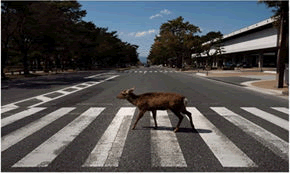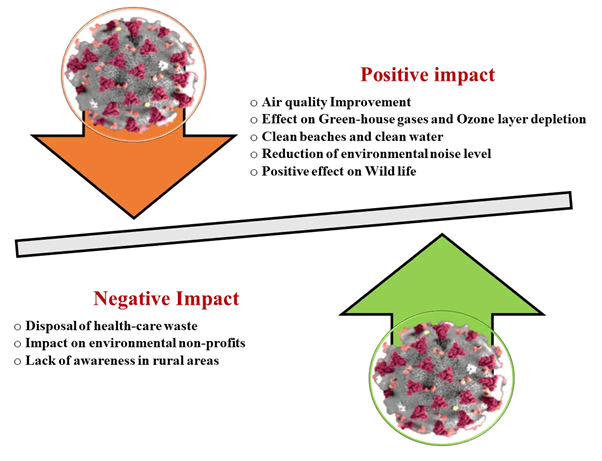Review Article - Microbiology: Current Research (2023) Volume 7, Issue 3
COVID-19: A pandemic with positive and negative effect on environment.
Nitin Sharma*, Sarbjeet Kaur, Usha Devi, Vikas Kumar
Department of Biotechnology, Chandigarh University, Punjab, India
- Corresponding Author:
- Nitin Sharma
Department of Biotechnology,
Chandigarh University,
Punjab,
India,
E-mail: abhinitu30@gmail.com
Received: 03-Apr-2023, Manuscript No. AAMCR-23-94096; Editor assigned: 06-Apr-2023, PreQC No. AAMCR-23-94096 (PQ); Reviewed: 20-Apr-2023, QC No. AAMCR-23-94096; Revised: 03-May-2023, Manuscript No. AAMCR-23-94096 (R); Published: 31-May-2023, DOI: 10.35841/aamcr-7.3.146
Citation:Sharma N, Kaur S, Devi U, et al. COVID-19: A pandemic with positive and negative effect on environment. J Micro Curr Res. 2023;7(3):146
Abstract
Coronavirus pandemic is threatening humans and causing incredible destruction and hardship, and has stopped the whole world completely, yet it has forced a play button for the environment. The present review attempts to compare the negative and positive impacts of corona pandemic on the environment in most affected countries like India, the USA, China etc. Coronavirus has positively affected the environment. Air pollution has dropped remarkably for many nations due to a complete lockdown with no traffic issues and shutdown of many industries, clean water resources, and reduced environmental noise. In addition to the earth's healing, the impact of waste has been a primary concern, as there is an increase in household waste collection and recycling due to coronavirus constraints. Medical waste disposal is another primary concern that needs to be taken up during this dreadful pandemic. The present review attempts to summarize both sides of the corona pandemic concerning the environment. It can be concluded from this review that it is mother nature who profited from the coronavirus due to the stoppage of all human activities.
Keywords
Coronavirus, Pandemic, Environmental pollution, Intervention.
Introduction
To date, COVID-19 remains a challenge to global public health. All countries of the world are fighting this COVID-19 pandemic. It was introduced in late December 2019, and several patients suffered from viral pneumonia caused by the unidentified microbial agent in Wuhan, China. The disease spread quickly from Wuhan to different zones and influenced all the worldwide nations by March 25, 2020, which raised severe consideration globally. This virus mainly affects the respiratory system and the International Committee on Taxonomy of Viruses (ICTV) named the virus coronavirus 2 (SARS-CoV-2) [1]. Although its source of origin is not confirmed, possibly the bat could be a primary source, but the transfer from bat to humans is not known. This infection's fast human-to-human spreading capacity has been built up. SARSCoV- 2 is the third highly pathogenic Betacoronavirus to infect human populations in the twenty-first century. Normal signs and manifestations of COVID-19 contamination include intense respiratory issue, for example, fever and shortness of breath. The average to longest incubation period is 5-6 days to 14 days respectively. In extreme cases, COVID-19 can cause pneumonia, intense respiratory condition, kidney failure and death [2,3].
On January 30, 2020, the first verified case of COVID-19 was reported in the Indian state of Kerala. Later, this spread to other regions of the nation and on March 4, 2020, 22 more cases were recorded. On March 12, 2020, the country's first COVID-19 fatality was verified. As the number of COVID-19 instances surpassed 500, Prime Minister of India issued a 14- hour public curfew on March 22, 2020. Followed by a 21-day countrywide shutdown [4]. The government advised Indian states and individuals to exercise social isolation as a prophylactic step against the nation's growing pandemic. All social venues, including retail malls and educational institutions, were shuttered during the nationwide lockout. Except for those providing vital services, employees were instructed to work from home, and all transport services for crucial infrastructure, including rail, road and air, were suspended. Nearly all manufacturing and construction operations remained closed. The complete shutdown adversely impacted the country's economy, but it also reduced air pollution due to reduced transport and industrial activity. Several previous reports showed the environmental aspects of corona pandemic. In the present review article, the environmental aspects of corona pandemic were discussed along with social challenges [5,6].
Literature Review
Environmental challenges associated with corona pandemic
The outbreak of corona pandemic, due to restricted social mobility, has led to the closures of several factories, a stop to education and training and reduced greenhouse gas emissions in developed countries. Due to severe restrictions on international travel, the outbreak has also affected our culture, sport, tourism, transport, production and several other industries. Due to these restrictions, the global aviation industry lost $100 billion. A study to determine the risk of the outbreak in the supply chain at the international level. Such a wideranging pandemic inevitably has devastating environmental consequences. Some of the harmful impacts of this pandemic on the environment are listed below [7].
Disposal of health-care waste: When corona pandemic was at its peak in Wuhan city, China, an average of 240 tons of medical waste was produced daily in hospitals which were six times higher than that of normal use. The fast global spread of coronavirus also raises the concerns about the proper disposal of medical waste. Many companies that deal with medical waste have begun offering services to clean environments of the coronavirus [8]. Moreover, it is becoming essential for governments to find solutions soon. In the meantime, any citizen must obey the rules while discarding face masks and other medical waste. Some people, including cleaners, garbage collectors and others who have to spend much time in public areas, are at higher risk of adverse effects from contact with medical waste. Some pathogens, such as meningitis and hepatitis B, may also be contaminated in the waste. Masks are composed of durable plastic-based materials that are resistant to liquids and are disposed of in the ocean or landfill. After one day, surgical masks are supposed to be discarded. In comparison, empty hand sanitizer bottles and solid tissue paper would produce an enormous amount of environmental and medical waste. In Hong Kong, for instance, where the COVID-19 outbreak began at the end of January 2020, medical waste has already tainted the environment. When seven million individuals all of a sudden begin using one or two masks, single-use gloves, and hand sanitizers daily, the quantity of waste generated will be considerable. The adverse effects of such medical waste are extensive. If they stay in an animal's natural environment, both on land and in the water, animals may mistake them for food and die as a result [9,10].
Impact on environmental non-profits: Coronavirus, one of the most lethal diseases, has broken the whole planet and is now striking internationally with devastating force. The charitable sector and non-profit organizations play a crucial role in assisting the government and the general public to face the impending disaster. Nonetheless, these nonprofits need assistance, participation, an d encounters.The coronavirus is already hurting some charities because of site closures, loss of paid-off work and cancelled fundraising. It will have a vast and lasting impact on their ability to care for our environment and wildlife. Some environmental charities are anticipated to experience a decline in revenue. Some environmental nonprofits have laid off almost two-thirds of their workforce. Environmental charities expect a longterm financial loss owing to a lack of donations, memberships and fund-raising [11].
A measure of social distancing taken by the government may not work for non-profits. Social distancing measures have also disrupted the charitable organizations that only rely on events to raise funds. According to the surveys, about 27% of environmental charities are at a high risk of becoming financially handicapped and 47% charities have funding for four months or less. Almost three-quarters of organizations are expected to hit funding restrictions from the government in future [12].
Lack of awareness in rural areas: The world keeps an eye on the effect of corona pandemic on developed countries like America, China and Russia. However, it is also necessary to know the impact of COVID-19 on developing countries, especially in rural areas. Lack of awareness of the current COVID-19 pandemic situation in rural areas has become a significant concern for all countries. Rural people depend on the daily marketing business of their agricultural products. Nevertheless, because of the COVID-19 pandemic lockdown, all transport, supply and purchase have been stopped. Hence the farmers are unable to sell their agricultural outputs to the market. To solve the problems in the rural areas, the government should have to start some plans that help the people in villages both the ways by financially and medically. By circulating awareness in various remote villages about safety rules and measures for spreading the virus, such as social distancing, wearing of masks and sanitization, we can fight against this virus [13-15].
Discussion
Positive impacts of corona pandemic on the environment and society
Air quality improvement: World Health Organization (WHO) estimated that around 3 million people die each year from air pollution-related ailments. More than 80% of urban dwellers are exposed to air quality levels that exceed permissible standards. However, 98% of low-income cities do not fulfill WHO air quality criteria. Air traffic has dropped by 96% as a result of the coronavirus pandemic, the lowest level in 75 years. COVID-19 has disastrous consequences for people's health and the global economy. However, by limiting economic and social activity, it minimises pollution. NO2 is a contaminant produced by the combustion of fossil fuels. It is very reactive. The primary source of NO2 emissions is believed to be traffic pollution. NO2 is extremely dangerous to human health, since studies demonstrate that both short and long-term NO2 exposure can raise death rates. Due to the onset of the COVID-19 pandemic, all industrial activity was halted, and all airplanes were delayed globally, leading in a reduction in emissions of greenhouse gases and air pollution all over the world. Environmental quality has improved, according to NASA (National Aeronautics and Space Administration) (2020) and ESA (European Space Agency) (2020) studies. Countries such as China, Italy, France, Spain, the United States, and Europe have reduced NO2 emissions by up to 30%. According to the community-multi-scale air quality model, air pollution in China is decreasing [16]. Similarly, reported on the reduction in air pollution in Barcelona, Spain, during corona epidemic. During the shutdown period in India, there was a considerable drop in the concentration of particulate matter with a diameter of 2.5 μm to 10 μm (PM10), particulate matter with a diameter of 2.5 μm or less (PM2.5), and NO2. However, O3 concentration increased during the lockout, which might be attributed to less O3 use in titration as a result of reduced NOx output. Several additional studies on air quality in other cities, including Lucknow, Delhi, and Gujarat, have indicated improved air quality during the lockdown [17].
Effect on green-house gases and ozone layer depletion: Since there is no public or private transportation operating during a corona pandemic, there is a drastic decrease in the production of greenhouse gases and harmful small, suspended particles. The shutdown of factories has also drastically cut down on the use of traditional energy sources like fossil fuels. Copernicus, Atmospheric Monitoring Services (CAMS), announced on April 23, 2020 that the ozone layer has been restored to some degree, providing protection from hazardous amounts of UV light to life on Earth. The experts, however, say it is not connected to changes in air quality and is instead the result of a powerful and long-lasting polar vertex.
Clean beaches and clean river water: Beaches have an essential role in natural capital assets in coastal regions and are crucial to the survival of coastal residents. However, owing to overexploitation, many beaches are polluted. People's social distancing techniques have reduced tourism near seashores and beaches across the globe. For example, today's beaches, like those in Acapulco, Mexico, Barcelona, Spain, and Salinas, Ecuador, seem cleaner and have crystal blue seas. Several publications in India have claimed increases in the quality of several rivers in India, including the Ganga, Cauvery, Sutlej, and Yamuna, which is potentially owing to fewer industrial effluents entering the rivers during this pandemic crisis. In Kanpur and Varanasi, Dissolved Oxygen (DO) levels have risen over 8 ppm from approximately 6.5 ppm, whereas BOD levels have fallen below 3 ppm from 4 ppm. Other factors that have led to better river quality are the melting of much snow now that it is summer, less water use in agriculture, more rain than usual, and fewer religious and cultural activities like puja, bathing, and cremations on river banks.
Reported that surface water quality in India's largest freshwater lake, Vembanad Lake, is improving in terms of Suspended Particle Matter (SPM). (2020) found significant reductions in heavy metals such as Se (42%), As (51%), Fe (60%) and Pb (50%) during the lockdown periods, as well as NO3 (56%), total coliform (52%), and faecal coliform (48%), in twenty-two groundwater samples from the coastal industrial town of Tuticorin in Southern India. Similarly, observed improved water quality metrics in the Dwarka River Basin of Eastern India following forced lockup.
Reduction of environmental noise level: Various humancause dactivitiesincluding manufacturing and commerce, the movement of motorized vehicles, and loud musican contribute to what is known as environmental noise. One of the most prominent causes of distress for humans organisms, environmental noise is known to exacerbate health issues and disrupt ecosystems. Many nationalities choose to stay at home during a quarantine. The noise levels in most urban areas of the world would drop dramatically if people stopped using cars, buses, and trains and stopped conducting business [18].
Positive effect on wild life: Human lockdown liberates space formerly occupied by humans and their activities. Many animals, including deer, peacocks, monkeys, elephants, birds, and dolphins, were brought to public notice worldwide during the coronavirus pandemic. Some scientists think the lockout has stopped a few birds from moving around and nesting in places where people live. Many migratory birds are returning in massive numbers to their lakes and bodies of water. Because there is no automobile noise, birds can communicate more effectively. Fishing activity has ended all around the planet. The Wildlife Institute of India (WII) has released a Lockdown Wildlife Tracker app on Google Play that allows real-time wildlife monitoring in human-restricted areas (Figures 1-4).
Indirect effects on environment: To stop the spread of novel coronaviruses in China and other countries, chlorine has been added to wastewater treatment facilities. Yet, the corona virus has not been detected in either potable water or wastewater. However, both humans and marine life might be negatively impacted by drinking too much chlorinated water. Both the positive and negative effects of the corona epidemic on global environment are displayed in Figure 5 [19-21].
Future challenges and preventive measures for COVID-19
In the future, social distancing and enhanced hygiene standards will be vital steps for avoiding the onset of community transmission. In addition, testing, tracking the prior encounter, isolating the sick individual and preventative self-isolation are essential for reducing the likelihood of infection. People's awareness and acceptance of pandemic prevention methods are also very important. Prior to tracking the reversal of the pandemic trend, such measures must be accompanied by a return to normal life and daily activities. Several clinical trials are under ongoing to create a vaccine or other remedy for the corona pandemic, but the results are anticipated. Vaccine development and approval may take many months. Priorities would remain timely detection, quick diagnosis, prompt isolation, and clinical care. Another issue is the recurrence of the COVID-19 epidemic, which may be prevented by implementing better containment measures and restricting their boundaries.
Conclusion
The coronavirus pandemic, perhaps too devastating for humans, may transform the scenario as it helps create a sustainable economy for the future and aims to avoid a worse ecological disaster, does not affect dead-end employment, and enables individuals to fight back. In this article, the effects of the corona outbreak and its lockdown on the worldwide environment, especially air quality, water quality, noise pollution, beaches, and animals, were thoroughly examined. This investigation will assist us in learning more about COVID-19 and the consequences of the shutdown on the environment within India and other nations. It may be concluded that if humans harm their climate, nature will put forth every effort to rebound. There is a possibility that once the lockdown period is over, the pollution of the atmosphere will allow us to evacuate with more efficiently, enabling our attempts to save the planet to have a profound effect.
Acknowledgement
All the authors acknowledge the support of CGC, Landran and Chandigarh University, Gharuan, Mohali.
Conflict of Interest
Nil.
Funding
Nil.
References
- Chen N, Zhou M, Dong X, et al. Epidemiological and clinical characteristics of 99 cases of 2019 novel coronavirus pneumonia in Wuhan, China: A descriptive study. Lancet. 2020;395:507-13.
[Crossref] [Google Scholar] [PubMed]
- Gorbalenya AE, Baker SC, Baric RS, et al. Severe acute respiratory syndrome-related coronavirus: The species and its viruses-a statement of the Coronavirus Study Group. BioRxiv. 2020.
- Holshue ML, DeBolt C, Lindquist S, et al. First case of 2019 novel coronavirus in the United States. New England J Med. 2020.
[Crossref] [Google Scholar] [PubMed]
- Lu R, Zhao X, Li J, et al. Genomic characterisation and epidemiology of 2019 novel coronavirus: Implications for virus origins and receptor binding. Lancet. 2020;395(10224):565-74.
[Crossref] [Google Scholar] [PubMed]
- Perlman S. Another decade, another coronavirus. N England J Med. 2020;382(8):760-2.
[Crossref] [Google Scholar] [PubMed]
- Xu Z, Shi L, Wang Y, et al. Pathological findings of COVID-19 associated with acute respiratory distress syndrome. Lancet Respir Med. 2020;8(4):420-2.
[Crossref] [Google Scholar] [PubMed]
- Bandyopadhyay S. Coronavirus Disease 2019 (COVID-19): We shall overcome. Clean Techno Environ Policy. 2020;22:545-46.
[Crossref] [Google Scholar] [PubMed]
- Yu KD, Aviso KB. Modelling the economic impact and ripple effects of disease outbreaks. Process Integr Optim Sustain. 2020;4:183-186.
- Nghiem LD, Morgan B, Donner E, Short MD. The COVID-19 pandemic: Considerations for the waste and wastewater services sector. Case Stud Chem Environ Eng. 2020;1:100006.
- Phan TL, Ching CT. A reusable mask for coronavirus disease 2019 (COVID-19). Arch Med Res. 2020;51(5):455-7.
[Crossref] [Google Scholar] [PubMed]
- Hellewell J, Abbott S, Gimma A, et al. Feasibility of controlling COVID-19 outbreaks by isolation of cases and contacts. Lancet Glob Health. 2020;8(4):488-96.
[Crossref] [Google Scholar] [PubMed]
- Dutheil F, Baker JS, Navel V. COVID-19 as a factor influencing air pollution? Environ Pollut. 2020;263:114466.
[Crossref] [Google Scholar] [PubMed]
- Faustini A, Rapp R, Forastiere F. Nitrogen dioxide and mortality: Review and meta-analysis of long-term studies. Eur Respir J. 1;44(3):744-53.
[Crossref] [Google Scholar] [PubMed]
- Srivastava S, Kumar A, Bauddh K, et al. 21-day lockdown in India dramatically reduced air pollution indices in Lucknow and New Delhi, India. Bull Environ Contam Toxicol. 2020;105:9-17.
[Crossref] [Google Scholar] [PubMed]
- He MZ, Kinney PL, Li T, et al. Short-and intermediate-term exposure to NO2 and mortality: A multi-county analysis in China. Environ Pollut. 2020;261:114165.
[Crossref] [Google Scholar] [PubMed]
- He L, Zhang S, Hu J, et al. On-road emission measurements of reactive nitrogen compounds from heavy-duty diesel trucks in China. Environ Pollut. 2020;262:114280.
[Crossref] [Google Scholar] [PubMed]
- Wang G, Zhang Y, Zhao J, et al. Mitigate the effects of home confinement on children during the COVID-19 outbreak. Lancet. 2020;395(10228):945-7.
[Crossref] [Google Scholar] [PubMed]
- Tobías A, Carnerero C, Reche C, et al. Changes in air quality during the lockdown in Barcelona (Spain) one month into the SARS-CoV-2 epidemic. Sci Total Environ. 2020;726:138540.
[Crossref] [Google Scholar] [PubMed]
- Kumari P, Toshniwal D. Impact of lockdown measures during COVID-19 on air quality-A case study of India. Int J Environ Health Res. 2022;32(3):503-10.
[Crossref] [Google Scholar] [PubMed]
- Selvam S, Muthukumar P, Venkatramanan S, et al. SARS-CoV-2 pandemic lockdown: Effects on air quality in the industrialized Gujarat state of India. Sci Total Environ. 2020;737:140391.
[Crossref] [Google Scholar] [PubMed]
- Mahato S, Pal S, Ghosh KG. Effect of lockdown amid COVID-19 pandemic on air quality of the megacity Delhi, India. Sci Total Environ. 2020;730:139086.
[Crossref] [Google Scholar] [PubMed]



